What is the Most Dangerous Asbestos?
Short Answer: All six types of asbestos are dangerous, and all can cause cancer.
But crocidolite (blue asbestos) is often said to be the most hazardous and poses the highest risk of cancer.
That said, chrysotile is the most commonly-used type of asbestos, and may pose the highest risk of exposure.
Again, all types of asbestos are hazardous, and all cause cancer. The National Cancer Institute has stated that:
“The overall evidence suggests there is no safe level of asbestos exposure.” 1
!
If you may have been exposed to asbestos, speak with your healthcare provider about tests and screening to help detect the presence of asbestos fibers and asbestos-related diseases.
Asbestos: An industrial term for a group of minerals
The term asbestos comes from an ancient-Greek word, but refers to six different types of rock that have similar properties for industrial use.
Asbestos is the term used to describe a group of naturally-occurring minerals with a deadly past and a problematic present. Asbestos was once hailed for its impressive (and seemingly miraculous) heat-resistant properties, and was used for centuries in a variety of applications. It was particularly favored throughout the construction and manufacturing industries until well into the 1980s, when its disastrous health risks became more widely understood.
| Chrysotile | Crocidolite | Amosite | Anthophyllite | Actinolite | Tremolite |
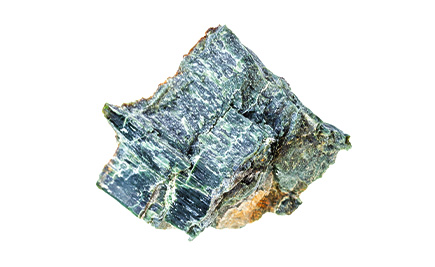 | 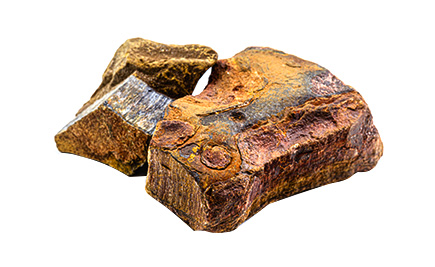 | 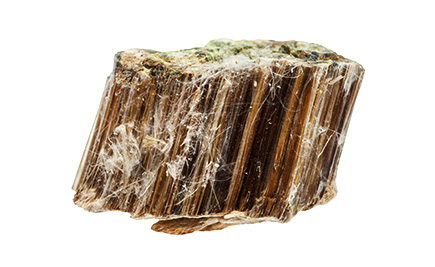 | 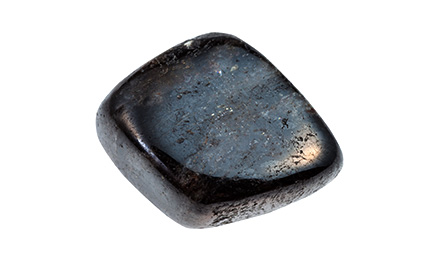 | 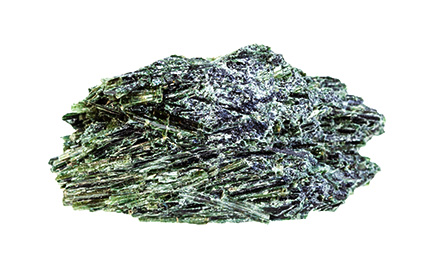 | 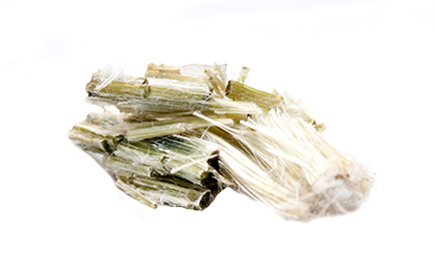 |
The six types of asbestos
There are six types of asbestos; chrysotile, amosite, crocidolite, tremolite, anthophyllite, and actinolite, with the first three being more commonly used than the rest. While each type has its own distinct appearance and unique properties, they all share one sinister trait – they are all extremely treacherous to human health when inhaled or ingested.
Chrysotile, also known as ‘white asbestos,’ is the most commonly used asbestos type, and is made up of long, curly, flexible fibers that are easy to spin into extremely strong, useful threads. Consequently, chrysotile was once used liberally in a myriad of products, including insulation, roofing materials, and brake pads.
Amosite, or ‘brown asbestos,’ has shorter, straighter fibers that are more brittle than those of chrysotile, and has a high iron content, giving it a distinctive brown color. While its use was rather less extensive than that of chrysotile, it was still widely employed, particularly in the manufacture of insulation materials and cement products.
Crocidolite, or ‘blue asbestos,’ is the most dangerous type of asbestos due to its thin, needle-like fibers. It was also commonly used in construction materials, such as pipe insulation and cement products.
The Blue Killer: Why Crocidolite is the Most Dangerous Asbestos
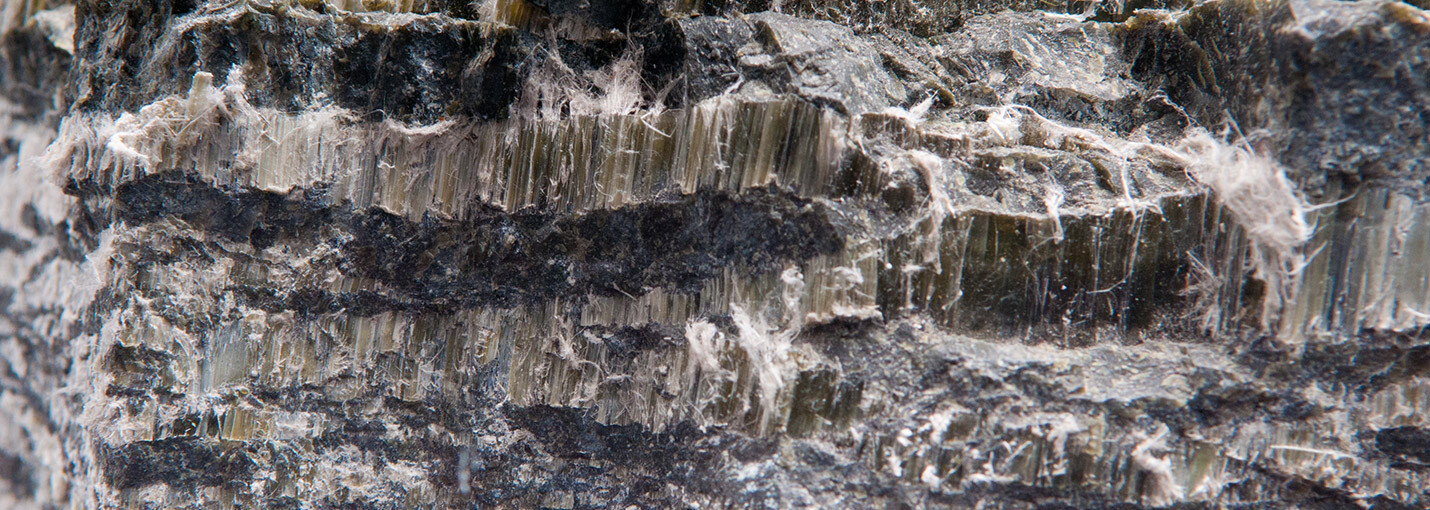
While all asbestos fibers can be inhaled and lodge into the lungs, crocidolite’s microscopic, needle-like fibers make even easier work of it than the rest. Crocidolite fibers are much thinner than those of other types of asbestos, making them even more likely to become airborne and thus, inhaled deeply into the lungs of anyone in the vicinity.

The American Lung Association has stated that once inhaled, some asbestos fibers never leave the body. 2
Once inhaled (or ingested), these fibers lodge into soft tissues, causing inflammation and scarring, which eventually develops into various lung diseases, such as lung cancer, mesothelioma, and asbestosis. Furthermore, crocidolite asbestos can break down in the presence of water, causing the potential for even more fibers to contaminate the environment.
Crocidolite asbestos in Kent cigarettes
Crocidolite was even used to make Kent cigarette filters back in the fifties – it’s disturbing to consider that this deadly carcinogen was added to a product that was already causing cancer all by itself.
Despite its dangers, crocidolite was utilized extensively the world over, and particularly in Australia, where it was heavily mined until the 1960s. A town called Wittenoom in Western Australia, was home to the world’s largest crocidolite mine – the Wittenoom Gorge Mine. It was permanently closed in 1966, but, of course, the damage had already been done. Today, Wittenoom is an abandoned ghost town, with most of the buildings having been razed, and asbestos fibers inevitably still lurking amongst the soil and rubble.
Do You Qualify For Compensation?
Quickly and easily find out how you were exposed by searching W.A.R.D., the largest asbestos database on the planet.
FREE SEARCH >From Ancient Artifacts to Modern Tragedies
Crocidolite has a rather fascinating history stretching far beyond its use in construction materials. In ancient times, it was highly prized for its deep blue hue and was often used in the making of jewelry and other decorative objects; the ancient Egyptians, for example, would use crocidolite to make small figurines, beads, and more.
Crocidolite used in expensive jewelry
Fast forward to the 19th century, and crocidolite was still being used to create beautiful (albeit artificial) gemstones, such as the famous “Etruscan” jewelry produced by the celebrated French jeweler, René Lalique. Back then, jewelry like this was made by heating crocidolite to a high temperature and coating it with a layer of silver or gold.
The prevalence of crocidolite use in jewelry-making declined in the early 20th century as the whispers of its dangers began to circulate more broadly. Tragically, however, its widespread use persisted, particularly in the manufacture of construction materials, until well into the colorful 1980s.
Asbestos Threats Persist
Today, the use of asbestos is heavily regulated in most countries, and thankfully, many have banished its use altogether. Nevertheless, asbestos is still present in many older buildings and products, and its dangers continue to pose a significant risk to human health.
Asbestos is durable, and not going anywhere
While no amount of exposure to any form of asbestos can be considered safe, crocidolite is the most deadly of them all. Mercifully, its use in the manufacture of construction materials and other commonly used products is a thing of the past, but its gut wrenching legacy still lives on in the many people whose lives have been devastated by its toxic fibers.
For those who live or work in an older building, the threat of potential asbestos exposure is real and must be taken seriously – particularly when construction materials are being disrupted, as this can cause the dangerous fibers to become airborne.
AsbestosClaims.Law
For Justinian C. Lane, getting compensation for asbestos victims is personal.
Justinian’s grandparents and his father all worked with asbestos in their younger years and died from asbestos-related cancers in their later years.
At the time of each of their deaths, no one in Justinian’s family knew that they were eligible to file an asbestos lawsuit and to seek compensation from the asbestos trusts.
Because no one in Justinian’s family knew their options, they never received any compensation for the death of their loved ones.
If you believe that you or your family member’s injury was related to asbestos exposure, you could be entitled to significant compensation.
This is money you could use to cover the costs of asbestos removal services, pay for medical treatment, and preemptively protect your physical well-being.
There are also asbestos trusts that offer compensation much more quickly and easily (without filing a lawsuit.)
If you’d like help with filing a claim, please get in touch by email at [email protected], or call or text us at (833) 4-ASBESTOS (427-2378) or (206) 455-9190. We’ll listen to your story and explain your options. And we never charge for anything unless you receive money in your pocket.
In addition to legal claims, veterans disability, social security and employment protection like workers compensation, FELA and The Jones Act for maritime workers, there are asbestos trusts that have been set up to compensate those harmed by asbestos without having to file a lawsuit.
There is no risk or cost to speak with one of our staff about your asbestos litigation. There are no fees unless you receive money.
If you have any additional questions or concerns related to asbestos, check out our website and YouTube page for videos, infographics and answers to your questions about asbestos, including health and safety, asbestos testing, removing asbestos from your home and building, and legal information about compensation for asbestos injuries.
Introducing the largest database of asbestos information on the planet.
W.A.R.D., which stands for the Worldwide Asbestos Research Database, helps clients to narrow down when and where they may have been exposed, as well as which products may still contain asbestos. W.A.R.D. will also help indicate compensation types and how much a person may be entitled to.
1 National Cancer Institute (NIH), Asbestos Fact Sheet.
2 American Lung Association, Asbestos, How Asbestos Impacts Health (updated 2022).